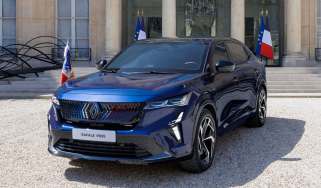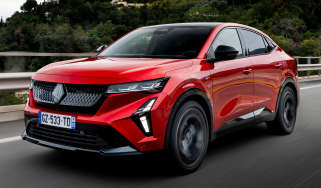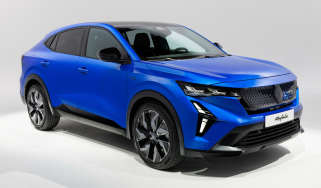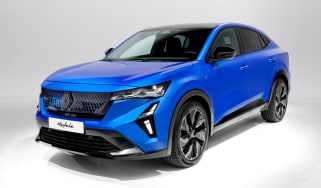Renault Rafale review
Renault’s stylish hybrid flagship features a tech-laden and spacious interior, but doesn’t drive as well as its upmarket SUV rivals

Our opinion on the Renault Rafale
The Renault Rafale is a coupe-SUV that the French can rightly be proud of. It’s also a vastly better showing in this niche, but very fashionable, segment than the less sophisticated Renault Arkana that came first. The Rafale delivers the stylish looks buyers want, its on-board tech is top-notch, and there’s plenty of space inside.
However, Renault’s flagship SUV is more of a show dog than a greyhound, because the standard full-hybrid powertrain struggles outside of town. Meanwhile, the plug-in hybrid version is more powerful, more refined and better for company car drivers, but it doesn’t deliver anything in the way of thrills, despite being tuned by Alpine, nor is it an especially adept motorway cruiser.
| Key specs | |
| Fuel type | Full-hybrid and plug-in hybrid |
| Body style | Coupe-SUV |
| Powertrain | 1.2-litre 3cyl petrol plus 1x e-motor, front-wheel drive 1.2-litre 3-cyl petrol plus 3x e-motors and 22kWh battery, four-wheel drive |
| Safety | Five-stars Euro NCAP (based on the 2022 Renault Austral test) |
| Warranty | Up to three years/60,000 miles |
About the Renault Rafale
The coupe-SUV is very on-trend right now, appealing to buyers who want something that looks dramatic on their driveway yet remains perfectly practical for everyday life. Initially kept to the confines of high-end premium brands, the niche has now spread to the mainstream, with cars like the Renault Rafale – the firm’s flagship hybrid SUV – sharing its sleek silhouette with cars like the BMW X4 and Audi Q5 Sportback.
But rather than a true rival for such premium models, the Rafale is much more of a rival to the latest Peugeot 3008, which has adopted a similarly rakish silhouette – or perhaps the Cupra Terramar that does without the sloping roofline but is certainly eye-catching and offers a well rounded driving experience.
The Renault Rafale is now available with either a full-hybrid powertrain producing 197bhp or a plug-in hybrid set-up that boasts 296bhp, four-wheel drive and a chassis that has been tuned by engineers from sports car maker Alpine. Both versions offer pure-electric driving capabilities, but the PHEV can cover up to 65 miles without using a drop of petrol.
Prices start from just over £38,000 for the regular hybrid model, with the PHEV starting at nearly £46,000. However, the latter gets a more complex powertrain, plus it comes in a higher specification from the jump.
Even the most basic Techno models come loaded with kit, including 20-inch diamond-cut alloy wheels, the two huge displays, a wireless smartphone charger, automatic dual-zone climate control, a reversing camera and various driver-assistance systems, such as adaptive cruise control, blind-spot monitoring and driver-attention alert.
Techno Esprit Alpine spec adds sportier styling, an exclusive wheel design, matrix LED headlights, a powered tailgate, four-wheel steering, a head-up display and Alcantara/leather upholstery. Iconic Esprit Alpine piles on a darkening Solarbay sunroof, 12-speaker Harman Kardon sound system, 360-degree camera and hands-free parking technology.
The top-of-the-range Atelier Alpine version is available exclusively with the plug-in hybrid powertrain, and comes with all the bells and whistles we mentioned. But it also adds chassis tweaks with new dampers, springs and anti-roll bars at the front and rear. Plus there’s bespoke ‘Agility Control’ modes that make changes to braking, regenerative braking, stability control and steering.
The 21-inch diamond-cut alloy wheels are fitted with Continental sports tyres as standard, and there is a front-facing camera that scans the road ahead and will make adjustments to the suspension to suit.
Performance & driving experience
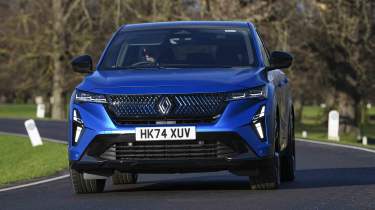
| Pros | Cons |
|
|
As we mentioned, the plug-in hybrid Rafale E-Tech 4WD 300hp, to give it its official name, has an impressive pure-electric range. But, according to Renault, the simpler full-hybrid version can still spend up to 80 per cent of town driving on pure-electric power. We have no reason to doubt that claim because we noticed the engine stayed mostly silent in built-up areas on our lengthy test route.
The Rafale’s regenerative braking set-up isn’t capable of full one-pedal driving, but comes much closer than many other hybrids, because its strongest setting can bring the car all the way down to a slow creep after the driver lifts off the accelerator. We also like the fact that there are paddles on the steering wheel for adjusting the regen’s strength on the fly.
Despite the fact that the Rafale sits on the same CMF-CD platform as the smaller Renault Austral, its suspension is tuned differently and features a 20mm wider track. Body movements are well controlled, but the Rafale isn’t an exciting car to drive on twisty roads, partly because of the uninvolving powertrain and partly due to the vague, incredibly numb steering. The brakes also require more force than you might expect before the car starts to really slow down.
We also have mixed feelings about the ‘4Control’ four-wheel steering that’s fitted on all but the base Rafale models. This allows for a turning circle of just 10.4 metres – the same as the Clio supermini – so it certainly helps with manoeuvrability on tight streets.
However, the system makes the car feel unnatural at low speeds. On faster corners, this system can also elicit a slightly disconcerting sensation that the back end is losing grip, even if it isn’t. Our test car was preset for the system’s maximum effect, which is meant to boost agility, but you can tone it down through the touchscreen to make high-speed driving feel more natural.
The range-topping Rafale PHEV is supposed to use its camera to inform the adaptive suspension what the road ahead looks like. But despite this, the ride is generally quite firm, and the car tends to bob when you hit a pothole or drive over any other imperfections in the surface. You also notice the thumps as you do so, which are fairly frequent on UK roads nowadays.
Overall, the ride is fidgety and unsettled, which prevents the Rafale from being a capable motorway cruiser. We suspect our test car also had an issue with its window seal, because we noticed some buffeting at high speeds, and were constantly checking to make sure the windows were completely closed.
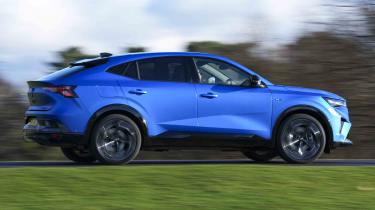
Performance, 0-60mph acceleration and top speed
Every Renault Rafale features a 1.2-litre three-cylinder petrol engine. In the full-hybrid version, it’s paired with a single electric motor that helps drive the front wheels, plus another e-motor to assist the petrol engine when needed, and act as a generator. Combined power output is rated at 197bhp and 205Nm of torque – enough for 0-62mph in 8.9 seconds.
However sudden demands for power or hard acceleration cause the engine to interject with a raucous tone. You’re often met with a few seconds of delay when you hit the throttle too, because the petrol engine needs a moment to wake up and produce its full power. Such a delay isn’t unusual in models with this type of hybrid system, but for a car that’s supposed to be a high-end product, it’s not a desirable trait.
For the Rafale E-Tech 4WD 300hp, Renault added a new turbocharger to the three-pot engine, boosting its power output to 148bhp and 230Nm. On the front axle is a 69bhp e-motor, and there’s another with 134bhp at the back driving the rear wheels, which makes this version four-wheel drive.
Finally, a third smaller 34bhp e-motor is used as a starter-generator and is linked to the six-speed automatic transmission. With all the components added together, there’s 296bhp on tap, which slashes the 0-62mph time down to 6.4 seconds.
Power delivery may be stronger, but the 1.2-litre engine still sounds thrashy as it gives you all it has got to move the nearly two-tonne Rafale. The choice of such an efficiency-focused engine also seems very much at odds with the Alpine-tuned chassis and other chassis upgrades found in the PHEV.
| Model | Power | 0-62mph | Top speed |
| Renault Rafale E-Tech hybrid 200 | 197bhp | 8.9 seconds | 111mph |
| Renault Rafale E-Tech plug-in hybrid 4WD 300 | 296bhp | 6.4 seconds | 111mph |
MPG & running costs
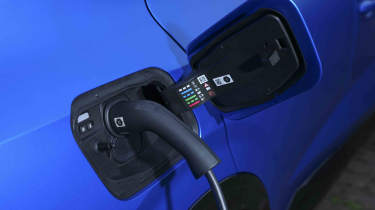
| Pros | Cons |
|
|
Unfortunately there’s no pure-electric version of the Rafale, but every model does feature hybrid technology that offers impressive levels of efficiency, particularly for a car of this size.
For starters, the full-hybrid Rafale E-Tech can return up to 60.1mpg and emits 105g/km of CO2, thanks in part to this car’s EV driving abilities around town. You don’t need to plug the car in anywhere to charge its 1.7kWh battery either, because that’s all done by the engine and regenerative braking system.
For comparison, a similarly electrified version of the Cupra Terramar can supposedly average 46.3mpg, and pumps out 140g/km. Meanwhile the latest Audi Q5 Sportback, which features its maker’s latest hybrid technology as standard, will achieve 40.4mpg at best and can release up to 177g/km.
The Rafale E-Tech 4WD 300hp emits as little as 12g/km of CO2, and boasts an official WLTP combined fuel efficiency figure of 564.9mpg. However, you’ll never see a figure that high from the car, partly because for whatever reason the digital driver’s display only reads up to 99.9mpg.
Plus despite our best efforts, including charging the car as frequently as possible, we only managed to average 44.8mpg in a plug-in hybrid Renault Rafale – less than 10% of what Renault claims it can do.
The standard Rafale attracts a 27% Benefit-in-Kind (BiK) tax rate, and basic-rate income taxpayers will pay just over £2,000 per year to run one as a company car. However, because of how efficient the Rafale PHEV is (on paper anyway), it attracts a BiK rate of just 8%, resulting in a much lower tax bill of around £800.
However, all but the most Rafale costs more than £40,000, meaning they attract the ‘Expensive Car Supplement’ of £410, which increases your annual road tax (also known as VED) bill to £600.
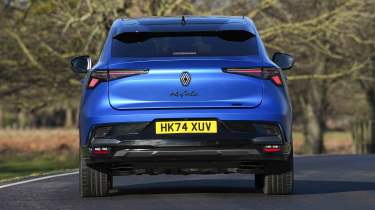
Electric range, battery life and charge time
Renault claims the Rafale E-Tech 4WD 300hp can run solely on its 22kWh battery for up to 65 miles and at speeds of up to 84mph. It also boasts an official WLTP combined fuel efficiency figure of 564.9mpg, with CO2 emissions as low as 12g/km.
With a maximum charging speed of 7.4kW, fully replenishing that battery will take just under three hours from a home wallbox capable of that speed.
When we tested the plug-in hybrid Rafale, it seemed to prioritise pure-electric driving, which on the one hand makes it feel like you’re driving an EV. However, this includes when you’re cruising along on the motorway, which meant we often got to the end of journeys with the battery nearly drained.
Our top tip for future (or current owners) is to use the E-Save mode as much as possible, because it's designed specifically to make sure there’s charge in the battery for when you need it - for instance, if you know you’re going to drive in town at the end of your journey.
| Model | MPG | CO2 | Insurance group |
| Renault Rafale E-Tech hybrid 200 | Up to 60.1mpg | 105g/km | 29-30 |
| Renault Rafale E-Tech plug-in hybrid 4WD 300 | Up to 564.9mpg | 12-15g/km | 38-39 |
Design, interior & technology
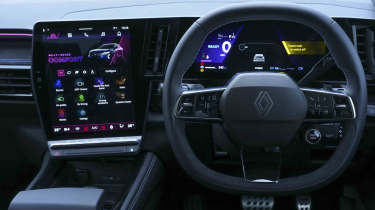
| Pros | Cons |
|
|
The Renault Rafale is a very impressive-looking car and bold enough to be the brand’s flagship SUV. Its slightly bullish design draws attention from pedestrians and other road users, especially if you choose the Satin Summit Blue paint.
Admittedly, you might think that the Rafale looks similar from certain angles to another French coupe-SUV, the Peugeot 408. That’s not a coincidence, because Renault’s current design boss Gilles Vidal, who oversaw the Rafale’s design, made the jump over from Peugeot a couple of years back.
We definitely wouldn’t call it a knock-off though, because the Rafale has been styled according to Renault’s latest design language. This includes lots of familiar elements, such as the complex front grille design with individual scales that allow you to see the body colour beneath.
There’s also nothing Peugeot-like about the interior. For the most part it’s the same as Renault’s mid-size family SUVs, the Austral and Renault Scenic. But to help lift the Rafale’s cabin to flagship status within the range, it does have some unique touches of its own such as unusual dyed cork or slate dashboard trim elements.
The seats have more side bolstering than those in other Renaults too, plus all but the base model get electric blue fabric stitching and lining in the door bins. All of which is designed to lift the familiar interior layout over and above other models in the range – not to mention rivals from other brands.
The top-of-the-range models we’ve tested also feature the company’s new ‘Solarbay’ panoramic sunroof. Instead of having a mechanical blind, the darkness of the glass itself changes at the push of a button from transparent to opaque, or even half-and-half. It’s a great party trick to watch, and something else that sets the Rafale apart.
Overall we’d say that the Rafale’s interior feels well screwed together and does wow passengers, but the material isn’t quite on the same level as the German cars benchmarked. The tech on-board helps make up for that, though, as does the amount of space on offer.
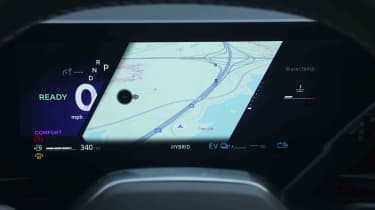
Sat-nav, stereo and infotainment
Every Rafale features a 12-inch portrait touchscreen and 12.3-inch digital driver’s display running Renault’s excellent Google-powered infotainment system. It’s a set-up that we’re very familiar with, given that it’s found right across Renault’s newer models.
The user interface itself is called OpenR Link, and it’s one of the best infotainment systems in the business. The displays are sharp and responsive, and the menus are always quick to load and intuitive because they’re laid out just like those on an Android smartphone. The system also comes with services like built-in Google Maps, with over 50 other apps also available. Wireless Apple CarPlay and Android Auto are standard-fit, too.
Boot space, comfort & practicality
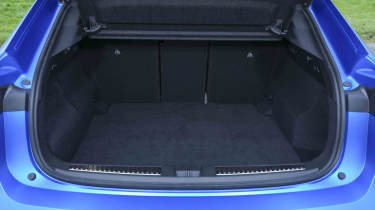
| Pros | Cons |
|
|
The Rafale’s heavily sloping roofline would suggest rear-seat passengers are going to be miserable. However this five-seat coupe-SUV is the same length (4.7 metres) and has the same wheelbase (2.74 metres) as the seven-seat Renault Espace, which is only sold in mainland Europe.
So in fact, those sitting in the back should have absolutely no complaints, because even six-foot-tall adults have headroom to spare, plus more than enough space to stretch out their legs. There’s almost no hump in the floor either, making it easier to squeeze three onto the rear bench. Alternatively, there are two sets of Isofix mounting points for child seats, with another set on the front passenger seat.
Rear-seat passengers will also appreciate the amenities available, in particular Renault’s ‘ingenious’ rear armrest that includes two cup-holders, USB-C charging ports and handy fold-out smartphone holders.
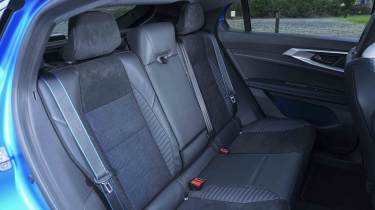
Dimensions and size
At 4,710mm long, 1,866mm wide and 1,613mm tall, the Renault Rafale is bigger than its chief rival, the Peugeot 3008, and isn’t far off the new Audi Q5 Sportback either.
Boot space
The 535-litre boot in the Rafale can’t quite match the 588 litres offered in the 3008, or the Cupra Terramar’s 540 litres, but it does manage to trump the Q5 Sportback’s 515 litres. You can, of course, fold down the seats in the Renault for a maximum of 1,600 litres of luggage capacity.
The Rafale doesn’t feature a sliding rear bench, like you’ll find in the smaller Renault Captur or Renault Symbioz, however the bigger issue is the lack of any underfloor storage for the plug-in hybrid version, and the charging cables take up a good amount of space in the boot.
| Dimensions | |
| Length | 4,710mm |
| Width | 1,866mm |
| Height | 1,613mm |
| Number of seats | 5 |
| Boot space | 535 litres |
Safety & reliability
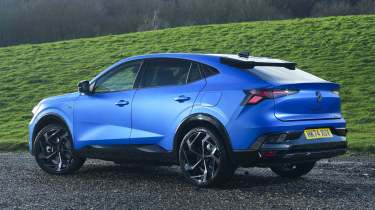
| Pros | Cons |
|
|
The Rafale Euro NCAP score is based upon the Renault Austral (tested in 2022) it shares a platform with, along with additional testing of the plug-in hybrid Rafale in 2024. It received the maximum five-star rating for its performance, plus 87 per cent scores for adult occupant protection and safety assist categories.
It certainly helps that the Rafale comes equipped as standard with advanced driver-assistance tech including adaptive cruise control, blind-spot recognition, an active emergency braking system with pedestrian and cyclist detection, driver-attention alert and lane-keep assist, plus much more besides.
But not everyone wants to have these fancy features on all the time, and Renault knows this because the Rafale has the brand’s brilliant ‘My Safety’ button located next to the driver’s right knee. With just two quick taps, this activates a personalised profile for the ADAS suite, making it super easy to silence the speed limit warning, for example.
Renault’s three-year/60,000-mile factory warranty is fairly standard, with brands ranging from Fiat to Audi providing customers with similar coverage. However, Hyundai provides extra peace of mind with its five-year/unlimited-mileage warranty, while sister brand Kia goes even further with a seven-year/100,000-mile warranty.
The Renault Rafale didn’t make it onto our latest list of the top 50 best cars to own, which is based on owners’ feedback from our annual Driver Power survey. In fact, no Renaults made the cut, while the brand finished a disappointing 28th (out of 32) in our best car manufacturer rankings.
| Key standard safety features | Euro NCAP safety ratings |
|
|
Renault Rafale alternatives
The Rafale was designed to rival coupe-SUVs from premium German brands, namely the Audi Q5 Sportback and BMW X4, by offering the same type of rakish silhouette in a similarly sized car, but with prices for the Renault starting from more than £15,000. Of course there are lots of other striking mid-size SUVs that compete with the Rafale, such as the latest Peugeot 3008, Volkswagen Tiguan and Cupra Terramar.
Renault Rafale pictures
Frequently Asked Questions
The Renault Rafale offers dramatic looks, a stellar interior and great Google technology, however it’s not as sharp or exciting to drive as its styling might suggest, and it’s not especially comfortable either.






